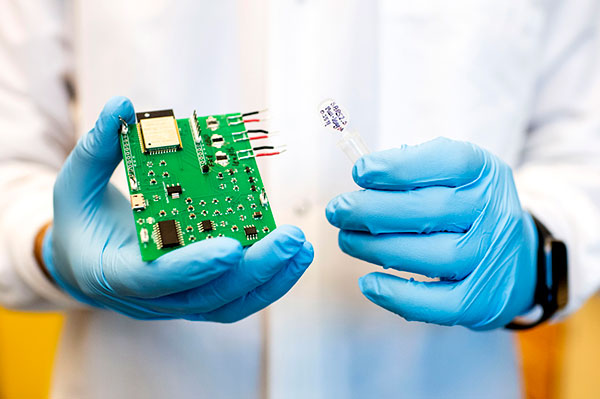Sensors to Detect COVID-19 Diagnosis Instantly

ECE Professor Nian Sun was recently awarded a $200,000 NSF RAPID grant for “COVID-19: New Handheld Gas Sensors for Airborne SARS-CoV-2 Virus: Instant COVID-19 Diagnosis from Exhaled Breath.”
In collaboration with Jeremy Luban from UMass Medical School, Sun aims to streamline the COVID-19 detection and diagnosis process.
The two will develop a handheld gas sensor for SARS-CoV-2 virus in air detection, using each of their fields of expertise. Sun specializes in sensors and electronics engineering, while Luban brings his virus, proteins, biochemistry and molecular pharmacology knowledge.
The project started on June 1, and Sun said they are hoping to have the first tests ready within one to two months. They are working to develop clinical trials and want to gain emergency use approval from the Food and Drug Administration (FDA), he said.
The SARS-CoV-2 sensors are unique in that they are sensitive enough to specifically detect varying mutated strains of COVID-19, Sun explained.
“Whether it is the Wuhan reference strain, or the mutated strain from the U.S., we can detect that,” he said. “There are spike protein variants with tiny changes, and our sensors can differentiate them.”
Simplifying disease detection
Sun explained that he had been working on building sensors that can detect and diagnose diseases for several years. A woman from Scotland made headlines when it was revealed that she could smell Parkinson’s disease, he noted. Researchers subsequently used a mass spectrometer to mimic that approach and help to detect Parkinson’s in patients.
Similarly, dogs are used for their sense of smell to detect drugs, weapons, and bombs, Sun stated.
“Why can we not do this?” he said.
That was six years ago, and he has since been perfecting his development and design of sensors that can detect disease. With the rise of the COVID-19 pandemic, it just made sense to pivot what he wanted the sensors to detect, Sun said.
The electromechanical sensors are significantly advanced compared to current testing measures. The gas sensor “will instantly detect SARS-CoV-2 in 1~2 seconds in exhaled breath and on surfaces, based on their demonstrated success on different gas sensors,” according to the grant.
Currently, the fastest COVID-19 detection tests take about five to ten minutes, Sun explained. With re-opening plans in effect across the country, he stressed the importance of being able to guarantee quick, accurate testing.
“When we open universities and schools, shopping malls, movie theaters, people want to know whether someone is a carrier of the disease or if they’re contagious,” he said. “When you can measure one person in two seconds, you can measure a lot of people in a very short time.”
The research is extremely promising toward ensuring a virus-free environment, he added.
“We want to come into the fight against COVID-19,” Sun said. “This is a serious problem, and we currently do not have a good solution against this virus. We’re hoping that as engineers, we can do our part to help out.”
Related News: Could This New Sensor Detect Coronavirus Particles in the Air?
Abstract Source: NSF
Infectious SARS-CoV-2 can persist in air for hours and on surfaces for days, threatening the lives of the general public, and of hospital staff. To address the challenges in the diagnosis of COVID-19, the two principal investigators (PIs) Nian Sun from Northeastern University and Jeremy Luban from UMass Medical School will develop a handheld gas sensor for SARS-CoV-2 virus in air, which will instantly detect SARS-CoV-2 in 1~2 seconds in exhaled breath and on surfaces, based on their demonstrated success on different gas sensors. Compared to other state-of-the-art technologies in the market for COVID-19 diagnosis, the proposed electrochemical sensor has multifold advantages, including ultra-high sensitivity and extreme selectivity, low-cost, and fast response and recovery. This work on novel electrochemical sensors for SARS-CoV-2 virus detection in air represents significant advancement in fundamental research on electrochemical sensors which are typically designed for molecules with much smaller sizes. These sensors will provide instant point of care diagnosis for COVID-19 and could be readily adapted for diagnosis of other diseases through sensing different biomarker chemicals.
These proposed SARS-CoV-2 sensors are novel electrochemical sensors with templated vacancies of SARS-CoV-2 particles, which leads to extremely high selectivity, sub-part per quadrillion (sub-ppq) sensitivity which is 6~9 orders of magnitude better than competitive gas sensors, fast sensor response and recovery time of 1~2 seconds, and long durability of over one year in different temperature and humidity environments. The two PIs have complementary expertise and resources needed for this project on sensors and electronics engineering (Sun), and on virus, proteins, biochemistry and molecular pharmacology (Luban). The PIs plan to carry out research tasks to include fabrication of SARS-CoV-2 gas sensors, sensitivity test, specificity test, and test specificity and sensitivity of SARS-CoV-2 sensors for spike protein variants that appear over the course of the pandemic. The iterative sensor fabrication and tests will be conducted to improve the sensor sensitivity and specificity of the gas sensors with SARS-CoV-2 and with control viruses, and to enable the SARS-CoV-2 sensor tests in ICUs and on humans for COVID-19 diagnosis.
This award reflects NSF’s statutory mission and has been deemed worthy of support through evaluation using the Foundation’s intellectual merit and broader impacts review criteria.